Los estabilizadores de bordado a máquina juegan un papel crucial para lograr resultados hermosos y profesionales en sus proyectos de bordado.. Ya seas un principiante o un bordador experimentado, understanding the various types of stabilizers and how to use them effectively is essential. ;
En esta guía completa, Nos adentraremos en el mundo de los estabilizadores de bordado., explorando su significado, diferentes tipos, and the factors to consider when choosing the right stabilizer for your project. ;

También le brindaremos valiosos consejos y técnicas para ayudarlo a preparar su tela y estabilizarla adecuadamente para bordar., solucionar problemas comunes, y garantizar el almacenamiento y mantenimiento adecuados de su colección de estabilizadores..
Al final de esta guía, Tendrá una comprensión completa del estabilizador para máquina de bordar y cómo usarlos para mejorar sus creaciones de bordado..
Unlock the Secrets Of Machine Embroidery Stabilizers –; Una guía definitiva
¿Qué es un estabilizador de bordado a máquina??
Piense en un estabilizador de bordado a máquina como la columna vertebral de su proyecto de bordado.. It’;es un material, típicamente hecho de papel, tela, o material no tejido, que proporciona soporte y estabilidad a la tela durante el proceso de bordado.
Por evitando la distorsión de la tela, frunciendo el ceño, y cambiando, Los estabilizadores garantizan que su diseño se mantenga nítido., limpio, y bien definido.
Importancia de los estabilizadores en el bordado a máquina
Máquinas de bordar Haz su magia cosiendo diseños intrincados en telas a altas velocidades.. Sin estabilizador, la tela puede arrugarse o estirarse, conduciendo a resultados imperfectos y decepcionantes.
Los estabilizadores proporcionan una base sólida para el bordado., permitiendo que la máquina cree puntadas precisas y evitando que la tela quede atrapada en la aguja o el aro.
En breve, Los estabilizadores son la salsa secreta que transforma tu bordado de aficionado a profesional..
Comprensión de los diferentes tipos de estabilizadores de bordado a máquina
No todos los estabilizadores son iguales, y diferentes proyectos requieren diferentes tipos de apoyo. Here’;s a rundown of the most common types of stabilizers you’;nos encontraremos:
Estabilizadores desprendibles
Los estabilizadores desmontables son fáciles de usar y quitar., haciéndolos una opción popular para principiantes. Suelen ser delgados, láminas no tejidas que se rasgan fácilmente, sin dejar residuos en la tela.
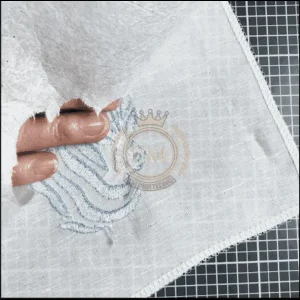
Los estabilizadores desprendibles son adecuados para tejidos estables y diseños con densidad de puntada mínima.
Estabilizadores recortables
Los estabilizadores recortables son duraderos y brindan soporte duradero.. Están diseñados para permanecer en la tela después del bordado., ofreciendo estabilidad incluso para diseños complejos y densos.
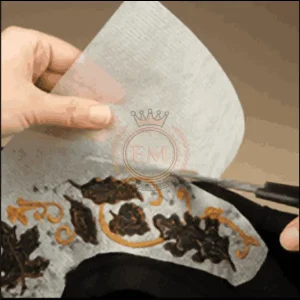
Los estabilizadores recortables son ideales para tejidos elásticos o delicados que necesitan refuerzo adicional..
Estabilizadores Lavables
Los estabilizadores lavables se disuelven o desintegran cuando se exponen al agua., sin dejar rastro atrás.
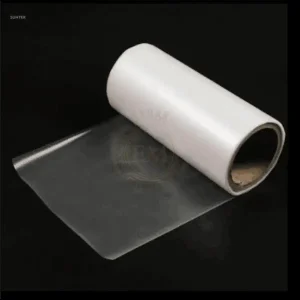
Son perfectos para telas que necesitan conservar su suavidad y caída., como encaje o materiales transparentes. Después del bordado, simplemente enjuague la tela para quitar el estabilizador.
Estabilizadores que eliminan el calor
Los estabilizadores resistentes al calor desaparecen cuando se aplica calor., como por ejemplo con un plancha o prensa de calor. They are excellent for fabrics that can’;No se puede lavar ni puede encogerse al exponerse al agua.. Los estabilizadores que eliminan el calor son una opción conveniente para telas como el terciopelo., terciopelo, o piel sintética.
Estabilizadores especiales
Además de los tipos principales mencionados anteriormente, También hay estabilizadores especiales diseñados para propósitos específicos..
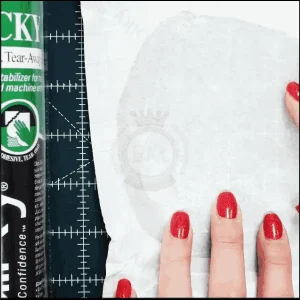
Los ejemplos incluyen estabilizadores con respaldo adhesivo para un fácil posicionamiento., Estabilizadores sensibles a la luz que desaparecen cuando se exponen a la luz solar., e incluso estabilizadores solubles en agua con elementos decorativos añadidos como purpurina.
Elegir el estabilizador adecuado para su proyecto
Con tantas opciones de estabilizadores disponibles, ¿Cómo eliges el correcto??
Considere estos factores al seleccionar su estabilizador:
Considerar el tipo y el peso de la tela
Ten en cuenta la tela. Los tejidos delicados y elásticos requieren estabilizadores más estables y de apoyo., mientras que las telas resistentes pueden necesitar menos refuerzo.
Evaluación de la complejidad del diseño
La complejidad de su diseño afecta la estabilidad requerida. Denso y complejo diseños de bordado a máquina Necesita un estabilizador más resistente para evitar distorsiones y cambios durante el bordado..
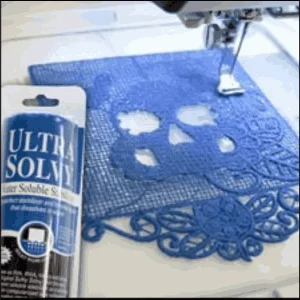
Evaluación de técnicas y estilos de bordado
Diferentes técnicas de bordado., como apliques o encaje independiente, puede requerir estabilizadores específicos para lograr los resultados deseados. Consider the technique and style you’;re utilizando al seleccionar su estabilizador.
Factores de presupuesto y disponibilidad
Los estabilizadores vienen en varios rangos de precios., así que considere su presupuesto al hacer una selección. también, Verifique la disponibilidad de estabilizadores en su área o en línea para asegurarse de que puede comprar fácilmente el tipo requerido..
Preparación de la tela y el estabilizador para bordar
Now that you’;He elegido el estabilizador perfecto., it’;Es hora de preparar tu tela y prepararte para bordar..
Técnicas de preparación de telas
Prepare su tela lavándola y secándola previamente para eliminar cualquier encogimiento.. Planchar la tela suavemente ayuda a lograr un bordado nítido..
Colocación del estabilizador y colocación del aro
Dependiendo del proyecto y tipo de estabilizador., Coloque el estabilizador debajo o encima de la tela antes de colocar el bastidor..

El bastidor adecuado garantiza que la tela y el estabilizador permanezcan tensos durante el proceso de bordado..
Asegurar el estabilizador a la tela
Para evitar que el estabilizador se mueva durante el bordado, asegúrelo a la tela con alfileres, clips, o aerosoles adhesivos. Esto asegurará que el estabilizador haga su trabajo de manera efectiva..
Con el estabilizador adecuado y la preparación adecuada, you’;Estás listo para embarcarte en tu viaje de bordado a máquina.. Asi que, elige tu diseño favorito, cargar el hilo, y deja volar tu creatividad!
Mantenimiento de sus estabilizadores
Técnicas para utilizar estabilizadores en bordado a máquina
Los estabilizadores de bordado son como los héroes anónimos del bordado a máquina.. Proporcionan el soporte y la estructura necesarios para garantizar que sus diseños luzcan impecables..
En esta sección, cubriremos algunas técnicas esenciales para utilizar estabilizadores de forma eficaz.
Guía básica de estabilizador de bordado para diferentes tejidos
Just like how you wouldn’;No usar tacones de aguja para un viaje de senderismo., no todos los tejidos requieren el mismo estabilizador. A la hora de elegir tu estabilizador, considere el bordado a maquina tabla estabilizadora para peso y elasticidad del tejido.
Las telas más ligeras como la seda pueden necesitar un estabilizador ligero, mientras que las telas más pesadas como la mezclilla pueden requerir algo más resistente. Experimentar y encontrar la combinación adecuada conducirá a los mejores resultados..
Estabilizadores en capas para mayor soporte
Algunas veces, one stabilizer just isn’;No es suficiente. Para refuerzo adicional, Intente aplicar capas de diferentes tipos de estabilizadores..
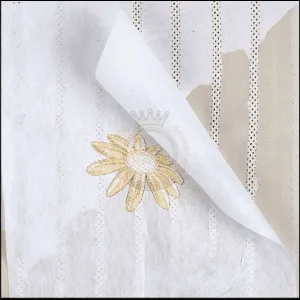
La combinación de un estabilizador recortable con un estabilizador removible puede proporcionar el equilibrio perfecto entre resistencia y fácil extracción..
It’;Es como usar tirantes y cinturón: doble soporte., duplicar el estilo!
Adaptación de estabilizadores para efectos de bordado específicos
Stabilizers aren’;No se limita solo a brindar apoyo.; También pueden ayudar a lograr diferentes efectos de bordado.. Para un efecto 3D, use un estabilizador soluble en agua encima de su diseño, coser encima, y luego enjuágalo.
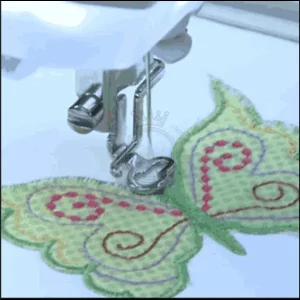
O, para una apariencia de encaje, Intente usar un estabilizador que desaparezca con la aplicación de calor.. Las posibilidades son infinitas, so don’;No tengas miedo de ser creativo.!
Explorando alternativas y combinaciones de estabilizadores
Los estabilizadores vienen en varias formas., desde láminas tradicionales hasta aerosoles e incluso opciones con reverso adhesivo. Cada uno tiene sus propias propiedades y usos únicos..
Don’;No tengas miedo de experimentar con diferentes combinaciones y técnicas para encontrar la que funcione mejor para ti..
Después de todo, El bordado es a la vez un arte y una ciencia.!
Solución de problemas comunes con los estabilizadores
Los estabilizadores pueden ser superhéroes, pero hasta ellos tienen su kriptonita. En esta sección, we’;Exploraremos algunos problemas comunes que puede encontrar al usar estabilizadores y cómo abordarlos como un profesional..
Técnicas de eliminación y residuos de estabilizadores
¿Alguna vez has terminado un bonito proyecto de bordado y te has encontrado con restos de estabilizador rebeldes adheridos??
No temas!
Hay formas sencillas de eliminarlo.. Desde arrancarlo suavemente hasta usar un removedor de adhesivo apto para telas, Puedes despedirte de ese molesto residuo y revelar la verdadera gloria de tu trabajo..
Prevención de desplazamientos y arrugas de la tela
Los movimientos y arrugas de la tela durante el bordado pueden ser tan frustrantes como un mal día con el cabello. Para prevenir esto, make sure you’;Vuelva a utilizar el estabilizador adecuado para su tela., asegurándolo adecuadamente, y evitando la tensión excesiva.

Seguir estos pasos garantizará que la tela permanezca en su lugar y que el bordado no se arrugue..
Abordar los problemas de tensión y rotura del hilo
Imagina tu máquina trabajando felizmente, sólo para ser detenido por un rotura de hilo o problema de tensión. Puaj, lo peor! Pero no temas, queridos bordadores.
Usando el estabilizador adecuado, checking your machine’;s ajustes de tensión, y asegurarse de que su hilo esté correctamente enhebrado, podrás esquivar estos molestos contratiempos y dejar volar tu creatividad.
Cómo abordar los problemas de compatibilidad del estabilizador
Algunas veces, Encontrar el estabilizador perfecto para un tejido y un diseño específicos puede ser como buscar una aguja en un pajar.. Si encuentra problemas de compatibilidad, como que el estabilizador no se adhiera correctamente o cause distorsión, don’;no te preocupes.
Intente ajustar el peso o el tipo de estabilizador., o incluso considerar usar una técnica diferente. Recuerda, El bordado se trata de explorar y encontrar lo que funciona mejor para ti..
Conclusión: Estabilizadores de bordado a máquina para dominar el bordado estelar
Felicidades, mis entusiastas del bordado! You’;hemos completado nuestro completo guía de estabilizadores de bordado a máquina. Armado con su nuevo conocimiento, you’;Estás listo para conquistar cualquier proyecto de bordado que se te presente..
Así que adelante, crear diseños impresionantes, y recuerda dar un gesto de agradecimiento a esos héroes anónimos llamados estabilizadores.
feliz costura!
EMdigitalización: Experto en digitalización de bordados a su servicio
Si estás interesado en algún tipo de proyecto de bordado., entonces EMdigitizing es la mejor opción para ti. Ofrecemos digitalización de bordados y servicios de arte vectorial con un tiempo de respuesta rápido. También puedes visitar y consultar nuestra web así como nuestros mejores servicios..
También ofrecemos una gran 50% Descuento en todos nuestros servicios para nuestros respetados clientes primerizos.. También ofrecemos cotizaciones gratis generado en tan solo 5 minutos.
Deberías aprovechar esta oferta por tiempo limitado y llevar tu proyecto de bordado al siguiente nivel con EMdigitizing.
Si tienes alguna consulta sobre este tema, puedes preguntarles. Gracias por tomarse el tiempo de leer este artículo..
Preguntas frecuentes:
The best stabilizer for machine embroidery often depends on the fabric type and the design’;complejidad. Los estabilizadores recortables se recomiendan ampliamente por su durabilidad y soporte., especialmente en tejidos elásticos o inestables, haciéndolos ideales para diseños que se lavarán o usarán con frecuencia.
Para determinar el estabilizador adecuado para el bordado a máquina, consider the fabric’;peso, textura, y estirar, as well as the embroidery design’;densidad. Las telas livianas generalmente requieren un estabilizador que se pueda desgarrar o cortar., mientras que las telas más pesadas pueden funcionar bien con opciones de estabilizadores más ligeras. Es aconsejable realizar pruebas en un pequeño trozo de tela..
Los estabilizadores para bordado a máquina vienen en varios tipos., incluido el desgarro, recortado, lavar, y alejar el calor. Los estabilizadores desmontables son fáciles de quitar, El corte proporciona más soporte para telas elásticas., lavar disolver en agua, y desaparecer por calor con aplicación de calor.
Choosing the “;better”; stabilizer is subjective and depends on the project’;sus necesidades. Los estabilizadores recortables ofrecen el mayor soporte y son excelentes para diseños de alta densidad en telas elásticas., mientras que los estabilizadores desprendibles son excelentes para proyectos rápidos en telas estables.. Los estabilizadores lavables son perfectos para telas delicadas o transparentes donde el estabilizador debe eliminarse por completo..
Generalmente, Los estabilizadores de bordado no son reutilizables porque están diseñados para brindar soporte durante el proceso de bordado y se eliminan o permanecen como parte del proyecto.. Sin embargo, El exceso de piezas de estabilizador de materiales recortados a veces se puede unir para usar en proyectos más pequeños..
